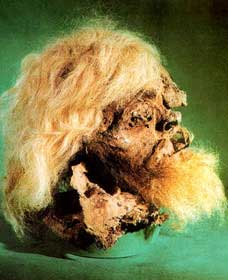Ancient “Salt Cured” Man Found in Iranian Mine
 (National Geographic) Another “natural mummy” — the sixth so far— has emerged in Iran’s Chehrabad Salt Mine, archaeologists say. The individual, who was naturally mummified by the preserving properties of salt over the past 1,800 years, was recently exposed when heavy rains pounded the salt mine. The functioning mine is located in the Hamzehlu region near Zanjan, a northwestern Iranian province. Scientists believe the man was a Roman Empire-era salt mine worker killed by falling rocks during an earthquake. Five other “salt men” have been found in the mine in recent years. They range in date from the Achaemenid period (539 to 333 B.C.) to the Sasanian era (A.D. 240 to 640). The salt men have proven to be scientific treasure troves, due to their advanced state of preservation. For instance, their beards, hair and garments have remained largely intact over time. Some still had food in their stomach.
(National Geographic) Another “natural mummy” — the sixth so far— has emerged in Iran’s Chehrabad Salt Mine, archaeologists say. The individual, who was naturally mummified by the preserving properties of salt over the past 1,800 years, was recently exposed when heavy rains pounded the salt mine. The functioning mine is located in the Hamzehlu region near Zanjan, a northwestern Iranian province. Scientists believe the man was a Roman Empire-era salt mine worker killed by falling rocks during an earthquake. Five other “salt men” have been found in the mine in recent years. They range in date from the Achaemenid period (539 to 333 B.C.) to the Sasanian era (A.D. 240 to 640). The salt men have proven to be scientific treasure troves, due to their advanced state of preservation. For instance, their beards, hair and garments have remained largely intact over time. Some still had food in their stomach.
Mystech: This one is for Lemon, although I think I still prefer the Mellified Man.
Yet this most recent find has prompted concerns about how Iranian officials will extract and preserve the man. Some Iranian officials say the first five salt men have given scientists plenty to study and the newly discovered man should remain in the ground for the foreseeable future.
Mohammad-Hassan Fazeli Nashli, director of the Iranian Centre of Archaeological Research, was recently quoted by Iranian media outlets saying he opposed the idea of unearthing the new salt man, mostly due to the country’s dearth of equipment and facilities for preserving it.
“There are still many serious problems in regard to the [five salt men’s] preservation,” Nashli told Iran’s Cultural Heritage News Agency in June.
“Iran is still a novice in protection of artifacts. Thus, when there is no critical question, it is better if we let the artifact remain in the earth, which is the best trustee,” he added.
Nashli did not respond to interview requests by press time.
But Thomas Stöllner, a professor at the University of Bochum in Germany, confirmed that Iranian scientists recently requested the assistance of Bochum’s German Mining Museum—where Stöllner also works— in studying the sixth man.
Stöllner has been to the Iranian mine, and he described the salt men as “outstanding.”
He said European and Iranian scientists are planning to conduct a field study to work on documenting the mines and to study ancient plants in the site.
Researchers have experience dealing with salt-preserved organic objects like tissue and fabrics, Stöllner said, but most lack experience in dealing with entire human bodies.
“Nobody has experience with salt-conserved bodies worldwide,” he said. “[We] need a complete new strategy on how to deal with them.”
Natural Mummies
Mummies are usually the product of human manipulation. But environmental conditions like extreme cold, dryness, and a naturally occurring mix of chemicals can also retard natural degeneration processes.
Extreme cold in the Andes Mountains, for example, has preserved Inca-era cadavers in Peru. And bodies dating to the Iron Age have been found in northern European bogs, preserved due to water acidity, cold temperatures, and a scarcity of oxygen.
“These salt men are extremely important,” said Daniel Potts, a specialist in Near Eastern archeology at the University of Sydney, Australia.
“There are many burials and cemeteries all over Iran, or indeed the Near East, with graves dating to these periods,” he said. (Related: “Noah’s Ark Discovered in Iran?” [July 5, 2006].)
But these graves don’t contain soft tissue or hair, let alone leather clothing, bags, footwear, belts or ropes, horn and bone-handled knives, and other organic items preserved by salt, Potts pointed out.
“If the Iranian government can collaborate with specialist laboratories and begin DNA analysis,” Potts said, “then these salt men could provide a huge amount of important data on the entire millennium between the Persian Empire and the coming of Islam.”







That’s just so cool. It sucks that the Iranian government probably won’t let anyone really investigate them. I wanna see ’em.
They remind me of those high altitude “natural” mummies in the Andes of Peru.